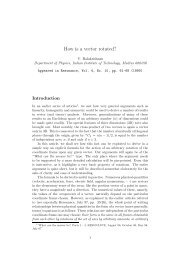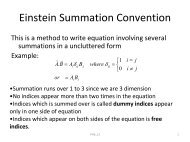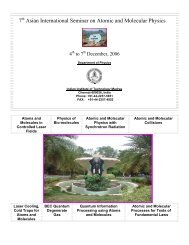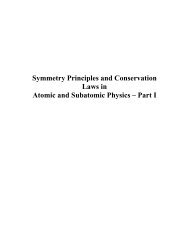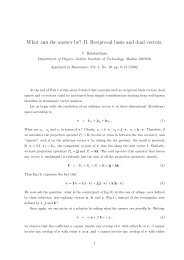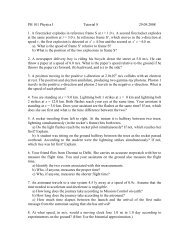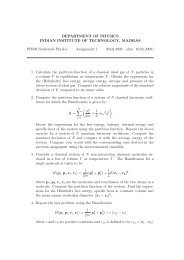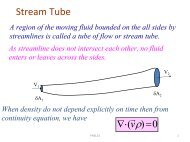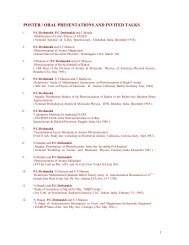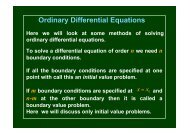Techniques in oscillatory shear rheology - Indian Institute of ...
Techniques in oscillatory shear rheology - Indian Institute of ...
Techniques in oscillatory shear rheology - Indian Institute of ...
You also want an ePaper? Increase the reach of your titles
YUMPU automatically turns print PDFs into web optimized ePapers that Google loves.
18 Abhijit P. Deshpandeics are observed. Therefore it is essential to establish the term<strong>in</strong>al periodic responsebefore analyz<strong>in</strong>g the LAOS data [8].Due to small gaps <strong>of</strong> rotational rheometer geometries, it is assumed that flowis one dimensional with tangential velocities. However, at large amplitudes and atthe edges <strong>of</strong> the geometries, secondary flows can develop. These may also lead toseem<strong>in</strong>g deviation from l<strong>in</strong>ear viscoelastic response or the appearance <strong>of</strong> higherharmonics. A homogeneous flow is also assumed (with constant velocity gradient,or stra<strong>in</strong> rate) across the depth <strong>in</strong> the rheometer geometry. Dur<strong>in</strong>g LAOS, the flowmay become <strong>in</strong>homogeneous (<strong>shear</strong> band<strong>in</strong>g; regions <strong>of</strong> different stra<strong>in</strong> rates) andtherefore, analysis <strong>of</strong> steady term<strong>in</strong>al response would be very difficult [17].Even though the presence <strong>of</strong> even harmonics is ruled out due to material symmetryconsiderations, they have been observed <strong>in</strong> several cases [4, 7]. These evenharmonicterms can be observed due to transient responses, secondary flows, viscousheat<strong>in</strong>g or dynamic wall slip. As an example, they have been shown to arise due tomisalignment <strong>of</strong> top and bottom geometry [4]. Edge fracture has also been shownto lead to higher harmonics <strong>in</strong>clud<strong>in</strong>g even ones [17].The <strong>in</strong>tensity <strong>of</strong> (n+1) th harmonic is usually <strong>in</strong> the range <strong>of</strong> 1–10% <strong>of</strong> the n th harmonic.Therefore, <strong>in</strong>tensities <strong>of</strong> successive harmonics are very low and it is difficultto ascerta<strong>in</strong> there significance. Due to these experimental issues, LAOS data need tobe exam<strong>in</strong>ed very closely before physical <strong>in</strong>terpretation <strong>of</strong> material response.3 Constitutive models and LAOSThe l<strong>in</strong>ear viscoelastic models such as Maxwell, Jeffrey’s, standard l<strong>in</strong>ear solidand generalized Maxwell model (comb<strong>in</strong>ation <strong>of</strong> Maxwell model as described <strong>in</strong>Sect. 1.3 are commonly used to describe the <strong>oscillatory</strong> <strong>shear</strong> response [2, 16]. Some<strong>of</strong> the simplistic phenomenological models for large deformations or nonl<strong>in</strong>ear viscoelasticitycan be considered as extensions <strong>of</strong> the l<strong>in</strong>ear viscoelastic models. Forexample, upper convected Maxwell model is,( )∂σσ+λ∂t + v · ∇σ −(∇v)T · σ − σ · ∇v = η ˙γ , (24)where the partial derivative from Eq. 4 has been replaced with upper convectedderivative (given <strong>in</strong> the parenthesis <strong>in</strong> the above equation).The quasi-l<strong>in</strong>ear model such as upper convected Maxwell model or Lodgerubber-like liquid and Oldroyd–B model lead to l<strong>in</strong>ear <strong>shear</strong> stress response forSAOS as well as LAOS [5, 21]. Therefore, they predict s<strong>in</strong>gle harmonic stressresponse, at the same frequency as the stra<strong>in</strong>. However, normal stress differencesare predicted to exhibit second harmonic [5] even at small stra<strong>in</strong>s. Additionally, allthese models predict the presence <strong>of</strong> higher harmonics dur<strong>in</strong>g the <strong>in</strong>itial stages <strong>of</strong>LAOS (before the term<strong>in</strong>al periodicity is established). These results are not surpris<strong>in</strong>gs<strong>in</strong>ce, the quasi-l<strong>in</strong>ear models exhibit no <strong>shear</strong> th<strong>in</strong>n<strong>in</strong>g behaviour. As is ap-



